Matador Network's Blog, page 165
May 22, 2024
The Best Airbnbs in Houston, Texas, With Pools and Backyard Facilities

Houston sizzles in the summer. It’s not only high temperatures. The city’s humidity can make it feel even warmer. This can make outdoor activities a little uncomfortable. So, having a pool where you can kick back after a day of exploring will make your stay much more enjoyable. There are some superb city center hotels with outstanding Southern hospitality and amenities. Still, if you’d prefer the comfort of a vacation rental, there are some epic Airbnbs that not only have refreshing pools but also great backyards.
Traveling to Texas? Check out Matador’s Texas accommodations guides: The best Texas Airbnbs to experience Lone Star culture The best Dallas Airbnbs, from a Deep Ellum warehouse to a family ranch 9 San Antonio Airbnbs within walking distance of the riverwalk The 9 most exciting boutique hotels in Dallas These 9 luxurious Houston Airbnbs are the best in the heart of the city The best Austin Airbnbs for large groups
We hope you love these Houston Airbnbs with a pool! Just so you know, Matador may collect a small commission from the links on this page if you decide to book a stay. Listed prices are accurate as of the time of publication.
Poolside loft near events and sports venues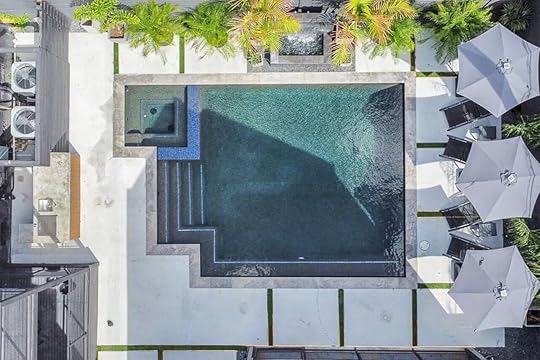 Photo: Airbnb
Photo: Airbnb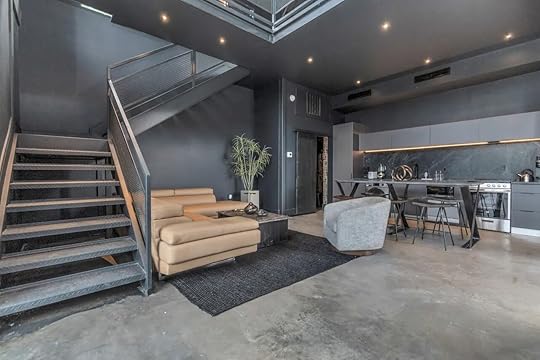 Photo: Airbnb
Photo: Airbnb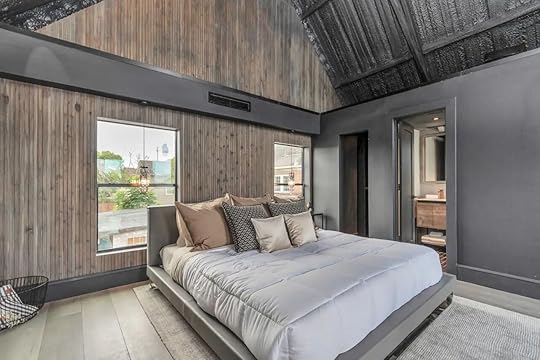 Photo: Airbnb
Photo: Airbnb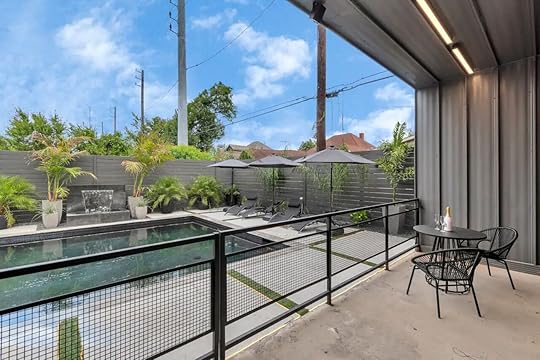 Photo: Airbnb
Photo: AirbnbSee more photosThis stunning home is in the Greater Third Ward. Nicknamed “The Tre,” the neighborhood offers a blend of the old and new and has attracted a crowd of young entrepreneurs and artists. Its proximity to Downtown Houston means you’ll have easy access to the central business district while still enjoying a more relaxed neighborhood atmosphere. The home is within a private gated complex and has a modern swimming pool and hot tub surrounded by greenery and sun loungers with parasols.
Four guests, one bedroom
Price: $404 per night
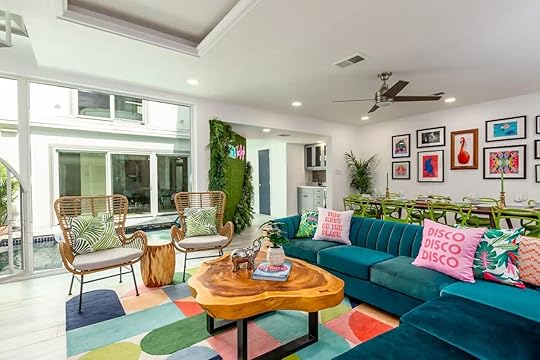 Photo: Airbnb
Photo: Airbnb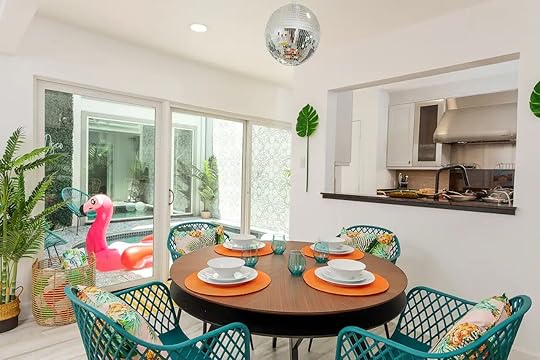 Photo: Airbnb
Photo: Airbnb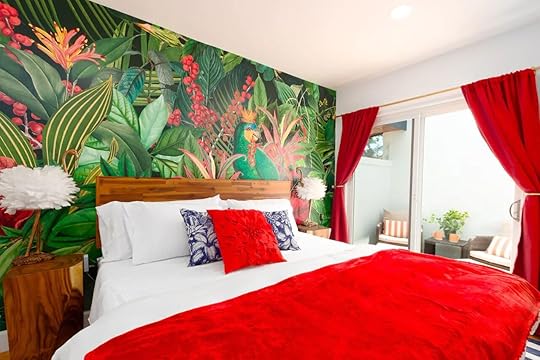 Photo: Airbnb
Photo: Airbnb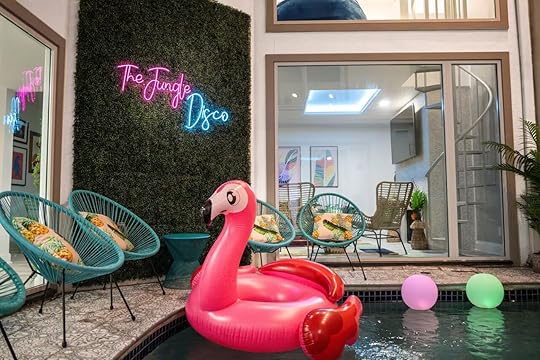 Photo: Airbnb
Photo: AirbnbSee more photosThis fun rental, called “Jungle Disco Home,” is located in Houston’s Museum District. This means you’ll be surrounded by art and culture, with museums like the Museum of Fine Arts and the Houston Museum of Natural Science within walking distance. The rental has an atrium pool, which means you can swim year-round regardless of the Houston weather. The décor of the Airbnb lives up to its name. Expect a playful and animal-themed atmosphere throughout the house, including pool inflatables and neon signs.
Eight guests, four bedrooms
Price: $455 per night
 Photo: Airbnb
Photo: Airbnb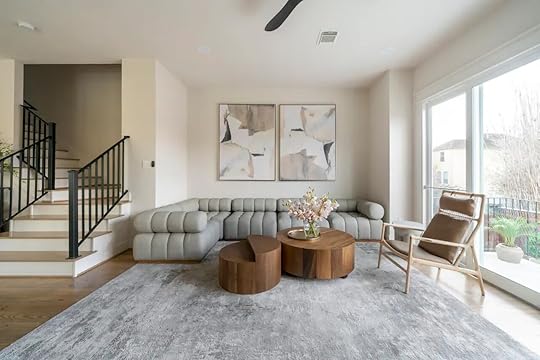 Photo: Airbnb
Photo: Airbnb Photo: Airbnb
Photo: Airbnb Photo: Airbnb
Photo: AirbnbSee more photosThis freestanding townhome’s pool is perfect for a quick plunge dip after a day in the city. The location is ideal for those who want to experience downtown’s excitement and the Heights neighborhood’s charm. The Washington Avenue entertainment district is steps away, offering a variety of excellent restaurants, bars, shops, and nightlife. You can easily walk this area or take a short drive to explore the rest of Houston. With a neutral color pallet and natural materials, the owners have created a very calming interior for the house. There’s no big or brash Houston energy here.
Eight guests, three bedrooms
Price: $579 per night
 Photo: Airbnb
Photo: Airbnb Photo: Airbnb
Photo: Airbnb Photo: Airbnb
Photo: Airbnb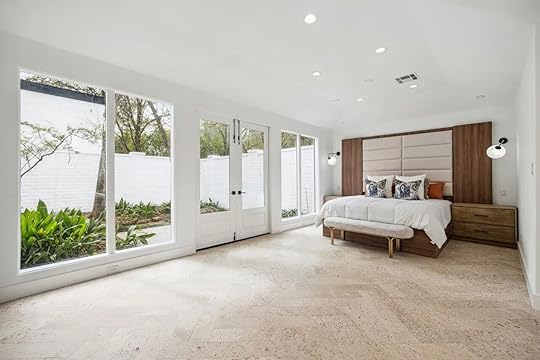 Photo: Airbnb
Photo: AirbnbSee more photosIf you’re looking for something more opulent and out of town, check out this five-bedroom mansion on an almost four-acre estate in Briagrove Park. Its grand architecture and impressive interior make this one of the most sought-after Airbnbs in Houston. As does the resort-style pool. Complete with sparkling fire features, a spa, and a cascading water wall, the pool will make it hard to leave the Briagrove neighborhood.
Twelve guests, five bedrooms
Price: $2,475 per night
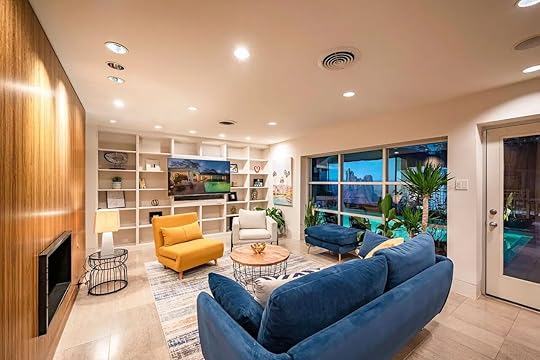 Photo: Airbnb
Photo: Airbnb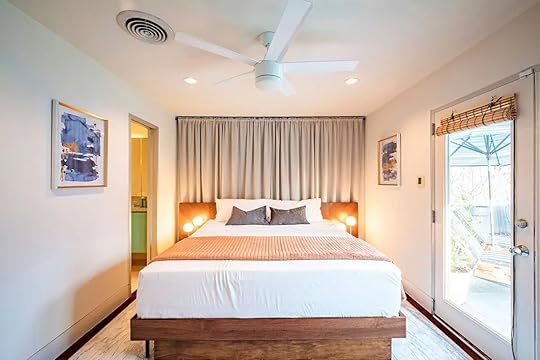 Photo: Airbnb
Photo: Airbnb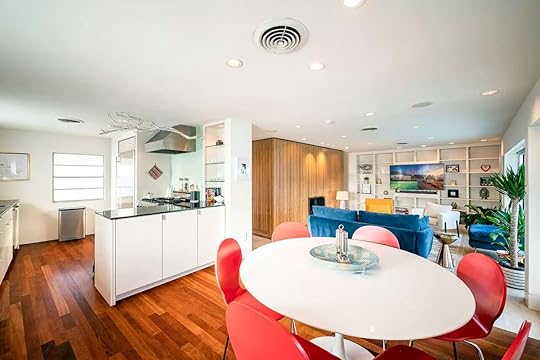 Photo: Airbnb
Photo: Airbnb Photo: Airbnb
Photo: AirbnbSee more photos
The hosts of this Airbnb list the property as a “Palm Springs-style” bungalow. Situated in Houston Heights, the beautifully decorated house has two bedrooms, a pool, and an outdoor entertainment area. The location puts you close to the action downtown but with a quieter, residential feel. Although this is not a wild party house – it’s a family-friendly area – it’s set up for entertaining, with an outdoor dining area with string lights. There’s even a screen beside the pool, so you can watch movies at night while bobbing on your inflatable.
Ten guests, three bedrooms
Price: $427 per night
 Photo: Airbnb
Photo: Airbnb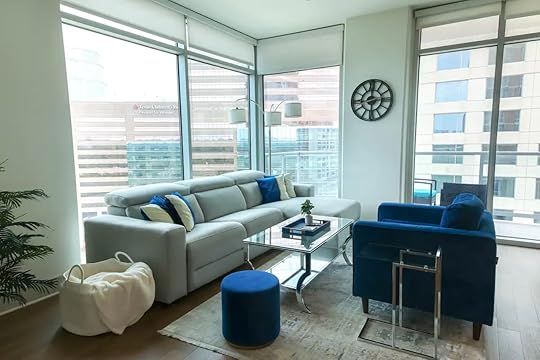 Photo: Airbnb
Photo: Airbnb Photo: Airbnb
Photo: Airbnb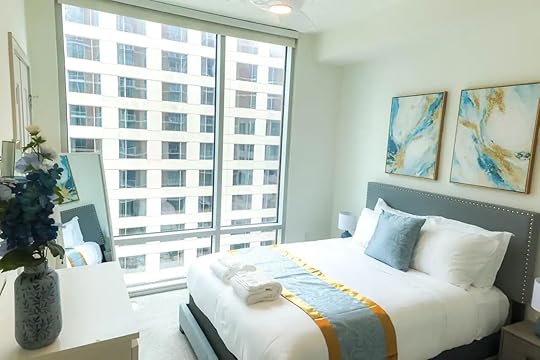 Photo: Airbnb
Photo: AirbnbSee more photos
This Airbnb is a two-bedroom, two-bathroom apartment located in Houston’s Texas Medical Center (TMC) area. The TMC is the world’s largest medical center, so if you’re in Houston for medical reasons, this location offers convenient access to world-class healthcare facilities. However, it’s also a good choice for those looking for an Airbnb experience with the amenities of a hotel. The apartment building has a gym, a rooftop pool with a lounge area and scenic views, and a 10th-floor lounge with a business center. A 24-hour concierge service is available to answer any questions throughout your stay.
Four guests, two bedrooms
Price: $204 per night
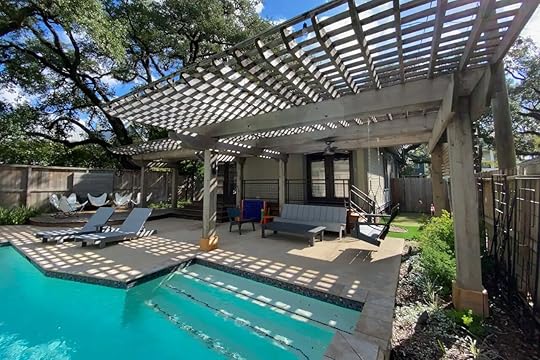 Photo: Airbnb
Photo: Airbnb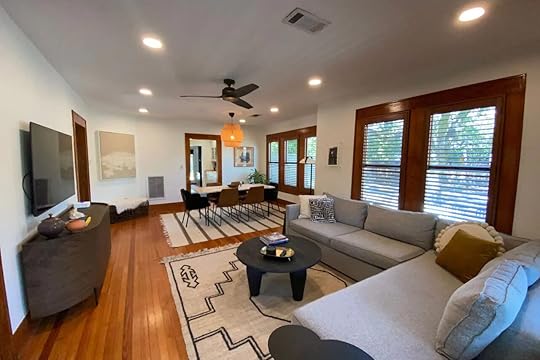 Photo: Airbnb
Photo: Airbnb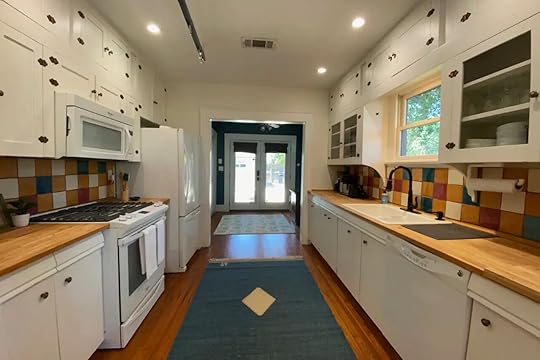 Photo: Airbnb
Photo: Airbnb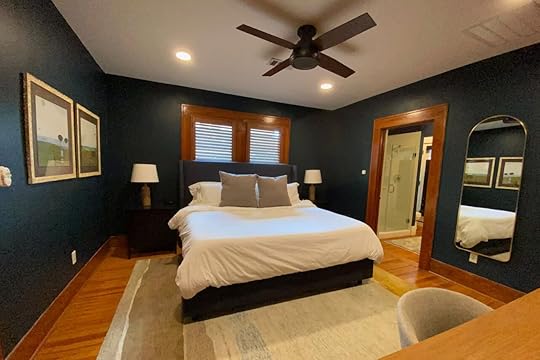 Photo: Airbnb
Photo: AirbnbSee more photosWith its heated pool and putting green, this bungalow is excellent for families. It comes with some extra kid’s toys and comfortably sleeps six. And there are plenty of things to see and do in the area. Houston Heights is a charming neighborhood northwest of downtown Houston that draws visitors with its historic streets, trendy shops, and vibrant food scene. Head to White Oak Music Hall to experience nationally recognized artists or catch a show at one of the many bars with live music. Also near the Airbnb is the Heights Hike and Bike Trail, which offers a scenic path that winds through the neighborhood.
Six guests, two bedrooms
Price: $362 per night
 Photo: Airbnb
Photo: Airbnb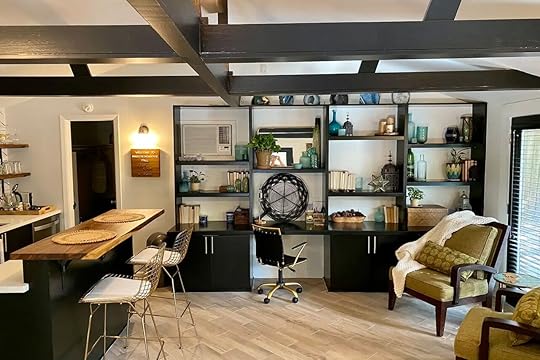 Photo: Airbnb
Photo: Airbnb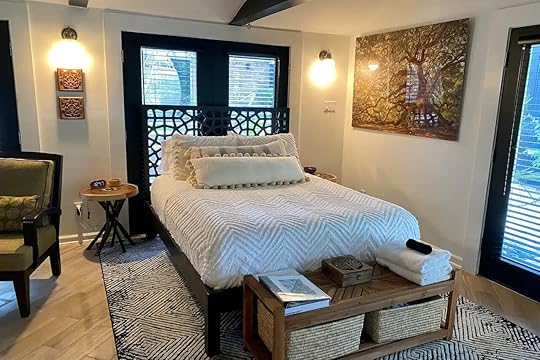 Photo: Airbnb
Photo: Airbnb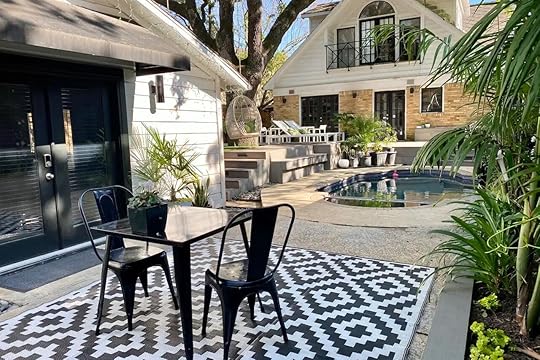 Photo: Airbnb
Photo: AirbnbSee more photos
If you’re a solo traveler or are a couple, bookmark this charming Houston home. I think it’s one of the prettiest rentals I’ve come across. The backyard has a lovely layout with an outdoor table and chairs, rattan hanging egg chairs, lots of potted plants, and a modest-sized swimming pool. A lot of love has gone into this guesthouse. The interior has natural tones, wooden beamed ceilings, chic gold finishes, and soft textiles. It’s in Montrose, which is one of the city’s most LGBTQ+-friendly neighborhoods.
Two guests, studio
Price: $181 per night
 Photo: Airbnb
Photo: Airbnb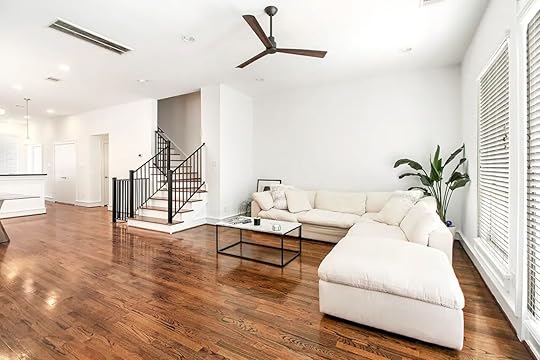 Photo: Airbnb
Photo: Airbnb Photo: Airbnb
Photo: Airbnb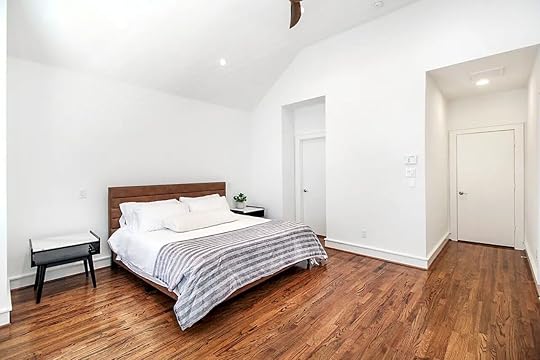 Photo: Airbnb
Photo: AirbnbSee more photosLocated in the Rice Military neighborhood of Houston, this three-story home has three bedrooms and is ideal for a group of friends or family. One of the biggest draws of Rice Military is its convenient location. The neighborhood sits within Houston’s Inner Loop, placing you just a stone’s throw away from downtown Houston to the south and the trendy bars and galleries of the Montrose neighborhood to the north. The Airbnb is also pet-friendly, has free parking, and has a private pool area with sun loungers and other outdoor seating leading out from the lower floor.
Seven guests, three bedrooms
Price: $380 per night
This Lightweight, Portable Chair Is Perfect From the Trailhead to the Campsite

Every now and then, a revolution comes along that makes me question my “conventional wisdom” surrounding outdoor gear. Two such events have happened this year. In January, I started snowboarding in ski boots, and this spring, I acquired a camp chair that makes all others I’ve owned seem unnecessarily bulky and irrelevant. That chair is the Helinox Zero. This chair is ideal for posting upon anywhere where you will only be temporarily – be that a trailhead, a parking lot, or a campsite. Matador outdoor editor Suzie Dundas and myself, gear and commerce editor Tim Wenger, break down the two primary use cases for this chair, and why it’s worth adding to your outdoor gear setup.
We hope you love the Helinox Zero! Just so you know, Matador may collect a small commission from the links on this page if you decide to make a purchase. Listed prices are accurate as of the time of publication.
Helinox Zero use case #1: At the trailhead Post-ride lounging, beer in hand. Photo: Suzie Dundas
Post-ride lounging, beer in hand. Photo: Suzie Dundas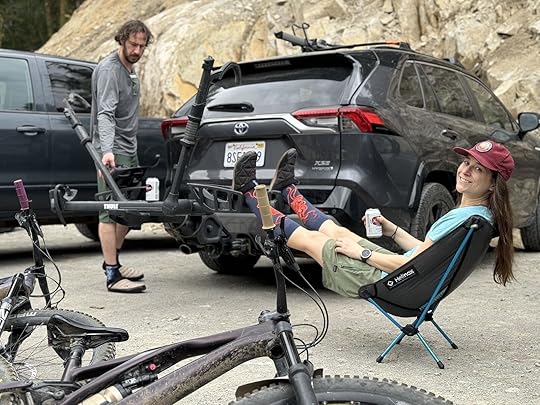 Post-ride lounging, beer in hand. Photo: Suzie Dundas
Post-ride lounging, beer in hand. Photo: Suzie DundasWhenever I go backpacking, I like to keep my pack as light as possible, bordering usually on the ultralight side of things rather than opting to carry extra luxuries. So when I first got the Helinox Zero Chair, a foldable and ultralight camp chair designed for backpackers, I wasn’t sure if I’d get much use out of it.
But I’ve had it now for about a year and actually do get tons of use out of it — not for backpacking, but for socializing after outdoor activities. Mountain biking is usually my go-to activity, and after a few hours of sweaty pedaling, it’s nice to sit and chill for a few minutes (or longer) before you peel off your smelly knee pads and load your bike back onto the car. And this is where the Helinox Zero really shines. Because it’s so narrow (about the thickness of a Nalgene water bottle), it’s easy to keep in my plastic bin of bike gear I haul in and out of the car each time. And when my legs are sore and fatigued, sitting in an actual chair feels downright luxurious, even if the chair itself is pretty basic. If we’re going to be hanging out in the parking lot for more than three or four minutes after a ride, I always set it up.
The best thing about the chair, in my opinion, isn’t how lightweight or small it packs up– it’s the speed of assembly and disassembly. I have lots of “packable” gear that can be a bit of a pain to put away, either because it just barely fits in the storage sack (my Patagonia Black Hole Tote) or has to be disassembled exactly the right way each time to make it fit (Therm-a-Rest LuxuryMap Self-Inflating Foam Camping Sleeping Pad). I love them both, but putting them away can be a bit of a time commitment.
But the Helinox Zero chair easily fits in the sack every time, even if you don’t fold the legs the same way or weirdly roll up the fabric seat. That means you can disassemble it in about 30 seconds, even while holding a conversation or focused on something else. Because of that, I never hesitate to set it up, and end up getting a lot of use out of it.
It’s not the most comfortable chair in the world (nor is it meant to be), but it does have a little bit of movement thanks to the flexible frame, and the lack of neck support isn’t much of an issue since you sit fairly upright. Stretchy shock cord between the poles means it more or less snaps together (i.e. no assembly steps to follow), and it holds up to 265 pounds, making it ideal for a wide variety of users, even though it looks pretty tiny.
Overall, I definitely recommend this chair. I get lots of use out of it thanks to easy assembly and disassembly. And I imagine it’d be ideal for backpackers who aren’t content sitting on the ground, since you won’t find a smaller or lightweight camp chair on the market. I think the reasonable price point ($149.95, but frequently discounted on Amazon) also makes it an excellent gift for outdoorsy people — especially outdoorsy people who appreciate a good parking lot beer in the sun after a long day of hiking, skiing, biking, or any other high-energy outdoor adventure. – Suzie Dundas
Helinox Zero use case #2: Backpacking and camping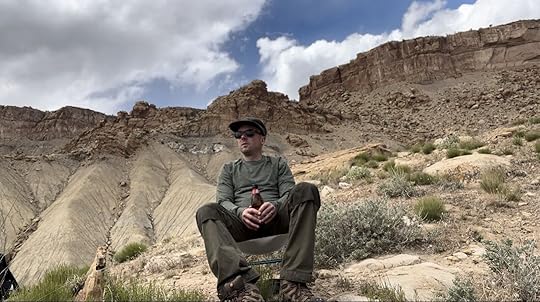 Beer tastes better on a mountain. Photo: Tim Wenger
Beer tastes better on a mountain. Photo: Tim Wenger The peak justifies as much attention as the chair -- but it's worth hauling it up there. Photo: Tim Wenger
The peak justifies as much attention as the chair -- but it's worth hauling it up there. Photo: Tim WengerI’ve for years kept camp chairs in the back of my Tacoma so that I always have one when I need it. Never did I think I’d change that course of action, or rather, condense it – I know keep a chair in my pack. The Zero measures 14” x 4” x 4” when packed, small enough to keep in backpacking and camping packs without forcing one to jettison other important pieces of gear. I tend to bring either a Patagonia Refugio or a larger backpacking pack with me when camping, and this season I’ve started keeping the Helinox Zero in whatever pack is coming with me. It weighs just over one pound.
I recently took it with me on a trip that required a 1,000-foot gain from trailhead to end point. As seen in the photos here, the chair fit well into my 30-liter pack. I’ve never brought an actual chair with me into the backcountry before, only one of those stoop-like seats, but after doing this once, I will do it over and over again. Besides its portability, the Helinox Zero chair excels at self-righteousness. By this I’m referring to its ability to remain right-side-up and stable even on less-than-flat surfaces (see the photo of me in the collage above), which are common at trailhead parking lots and campsites. I’ve popped the chair open and assembled it (in less than a minute) in a variety of such settings. As Suzie notes, you’re not going to rock yourself to sleep in this chair, but it’s supportive, easy on the back, and never leaves me feeling like I’m about to tip over – a common issue with traditional camp chairs.
 The chair comes apart in seconds. Photo: Tim Wenger
The chair comes apart in seconds. Photo: Tim Wenger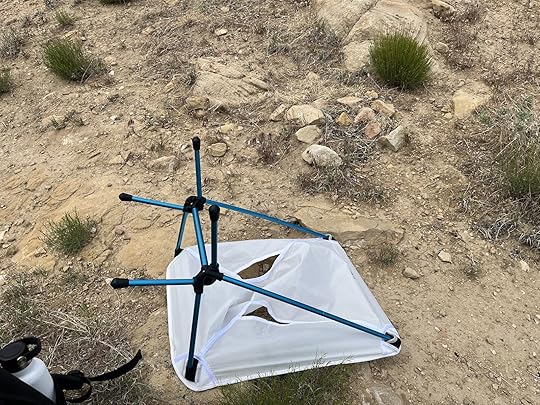
 Side view. Photo: Tim Wenger
Side view. Photo: Tim WengerThe Helinox Zero’s quick assembly – all you gotta do is unfurl the DAC aluminum alloy frame and then place the Aramid ripstop fabric seat onto the four connection points – makes it perfect for lounging by the campfire, at the trailhead, or even on your front porch. It disassembles just as quickly. All you gotta do is tug the pull-chords on the base mat and the frame releases. Then, it’s a few seconds of pulling the alloy tubes out and stuffing it all back into the carrying case.  – Tim Wenger
– Tim Wenger
Why You Have to Tell a Flight Attendant if a Phone or Laptop Falls Between Seats

Flights attendants are not glorified waiting staff. They are highly trained professionals whose job is, first and foremost, to keep passengers safe. So when they ask you to do something, whether that’s opening the window shades prior to take-off, switching your phone into airplane mode, or buckling up your seatbelt, you should just do it without protest. That includes notifying them if one of your personal electronic devices falls in between seats. They don’t make this very particular announcement at the start of every flight for no reason.
A lot of the electronic devices you carry with you when you travel are powered with lithium batteries, including cell phones, laptops, tablets, watches, cameras, portable external battery chargers, power banks, and more. The problem with lithium batteries is that they can overheat and sometime even create sparks if they are “damaged, overheated, exposed to water, overcharged, or improperly packed,” the Federal Aviation Administration (FAA) explains.
That’s why air travelers are not allowed to keep lithium battery-powered devices in their check-in bags — in case a fire breaks out in the luggage hold mid-flight. Instead, they must have them in their carry-on bags or personal items so that the devices can be monitored and, in the event of a fire, it can be put out.
An electronic device that falls in between airplane seats can easily get damaged, potentially leading to a battery fire. It’s especially true if the passenger tries to retrieve the device on their own by moving their seat. That’s why you notify the flight attendants so they can get it for you safely.
“We basically get on our knees and look for them. Most of the time they are easy to retrieve, just by removing seat cushions for easier access,” Nicolas Bessuejouls, who has been working as a flight attendant for the past 16 years, tells Matador Network. “Most of the times they are just adjacent to the seat and are very simple to reach. In Fist Class and Business Class it is more complicated as the seats are wider and have more mechanics,” he continues.
But what if the crew cannot retrieve the device? In this case, the passenger will have to wait until the plane has landed and ground maintenance personnel retrieves it. They will either remove parts of the seat to get access underneath, or dismantle it entirely, explains Tyler Herbert, an experienced airline pilot in Canada, in an email conversation. In the meantime, the seat cannot be adjusted in any ways. Herbert also says that he has seen phones retrieved after passengers move their seat and he confirms that they are “totally smashed.”
According to Herbert, devices get stuck between seats all the time. “People lay down and fall asleep and their phone falls off their body or out of a pocket and down a crack,” he says.
Just a few days ago, on Sunday May 19, 2024, a laptop that got stuck and could not be retrieved led to a United Airlines flight from Zurich to Chicago to turn back over the Atlantic Ocean and make an emergency landing in Ireland. The fire hazard was too great for the flight to continue.
“A fire on the plane while airborne is one of the worst emergencies that can occur,” Herbert explains. While there are fire extinguishers on board airplanes, however “if the fuel to the fire is blocked by a chair this can make it difficult to extinguish. If there is a fire on board this requires an immediate landing at the nearest airport,” he continues.
To date, the FAA has recorded 22 lithium battery air incidents in 2024. These incidents involved “smoke, fire, or extreme heat,” the report explains. 
Experience the Best of Honolulu at These Luxury Resort Hotels

There are a myriad of stunning hotels in Honolulu on O’ahu in Hawai’i if you’re planning an island adventure. For those who want to venture into Waikiki and explore the sand and sea, experience some urban activities like shopping and dining, or explore the rich culture of this island that’s affectionately referred to as Hawai’i’s “gathering place,” here are nine Honolulu hotels that go above and beyond in offering visitors a truly welcoming feeling of Hawaiian hospitality.
Traveling to Hawai’i? Check out Matador’s guides to the best places to stay on every island:9 of the most breathtaking Airbnbs on MauiThe coolest Airbnbs on O’ahuThe best Airbnbs on Hawai’i’s Big Island13 stunning yet affordable Airbnbs on KauiThese Hotels on Hawai’i’s Big Island Showcase the State’s Best BeachesWe hope you love the Honolulu hotels we recommend! Just so you know, Matador may collect a small commission from the links on this page if you decide to book a stay. Listed prices are accurate as of the time of publication.
Prince Waikiki Honolulu Photo: Vio.com
Photo: Vio.com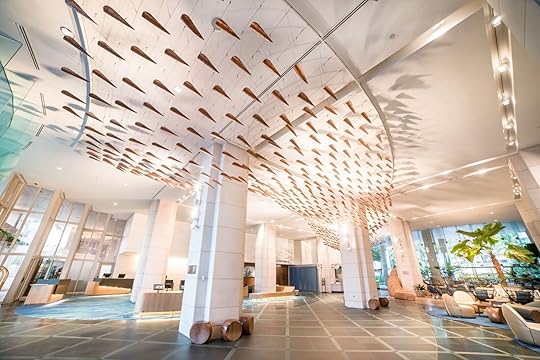 Photo: Vio.com
Photo: Vio.com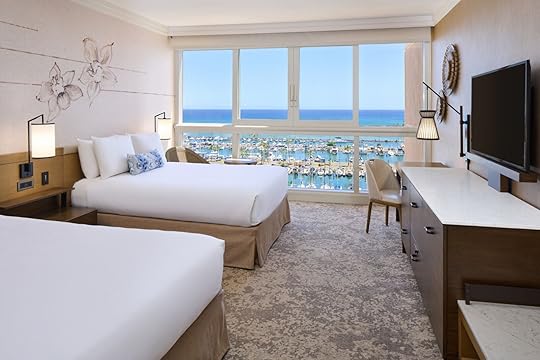 Photo: Vio.com
Photo: Vio.comSee more photos
This well-known property is located in western Waikiki, with fabulous views of Ala Wai Harbor and easy access to boating on the water. Spend time dining at one of the multiple on-site restaurants, lounging at the two pools (one of which is a gorgeous infinity pool), or take one of the free hotel shuttles to the local beaches. Immediately upon walking into the bright, airy lobby which is decorated with local art and features and light wooden tones and hues of sea blue, you’ll feel like you’re being whisked away on a traditional Hawaiian vacation. The guest rooms feel fresh and modern — and although there aren’t any rooms with balconies, the floor-to-ceiling windows offer impessive harbor views.
Prince Waikiki Honolulu: 100 Holomoana St, Honolulu, HI 96815
ESPACIO The Jewel of Waikiki Photo: Aqua-Aston Hospitality
Photo: Aqua-Aston Hospitality Photo: Aqua-Aston Hospitality
Photo: Aqua-Aston Hospitality Photo: Aqua-Aston Hospitality
Photo: Aqua-Aston HospitalitySee more photos
If you’d prefer a little more privacy, ESPACIO offers nice individual suites occupying an entire floor, each with a private entrance, expansive living area, and gourmet kitchen. The location is unbeatable, walk out the door, and you’re just steps from the world-famous Waikiki Beach. Each suite is oceanfront, with a private balcony with a Jacuzzi and a luxurious daybed canopied for shade. Extras such as a butler service, a rooftop sun deck with a swimming pool, an on-site spa, and a fine dining restaurant make ESPACIO one of the best all-around self-catering hotels in Waikiki.
ESPACIO The Jewel of Waikiki: 2452 Kalākaua Ave, Honolulu, HI 96815
Halepuna Waikiki by Halekulani Photo: Vio.com
Photo: Vio.com Photo: Vio.com
Photo: Vio.com Photo: Vio.com
Photo: Vio.comSee more photos
When you walk into the lobby of Halepuna, it feels like stepping into a tropical dream with serene tones of white marble, light wooden furnishings, and pops of pink accenting the dreamy design. The guest rooms are bright, clean, and upscale, and the views of the ocean across the street are awe-inspiring. This peaceful property is as close to the beach as you can get without actually being beachfront, and it’s in a central location just a short walk away from many of the major shops. There’s an infinity pool on-site with ocean views and poolside service, and a spacious fitness center with modern workout equipment. This property is a perfect place to stay if you’re in search of a luxurious, low-key getaway.
Halepuna Waikiki by Halekulani: 2233 Helumoa Rd, Honolulu, HI 96815
Ilikai Hotel & Luxury Suites Photo: Aqua-Aston Hospitality
Photo: Aqua-Aston Hospitality Photo: Aqua-Aston Hospitality
Photo: Aqua-Aston Hospitality Photo: Aqua-Aston Hospitality
Photo: Aqua-Aston HospitalitySee more photos
Famed for being featured in the opening sequence of the classic Hawai’i Five-O television series, the Ilikai Hotel & Luxury Suites oceanfront is ideal for exploring all that Waikiki has to offer. Guests are just a short stroll from the world-famous Waikiki Beach and the Ala Moana Center, the largest open-air mall in the world. The spacious suites, each featuring a full-sized kitchen equipped with modern stainless steel appliances and granite countertops, have private balconies with breathtaking panoramic views of the Pacific Ocean and the scenic southern shore of O’ahu.
Ilikai Hotel & Luxury Suites: 1777 Ala Moana Blvd, Honolulu, HI 96815
Outrigger Waikiki Beach Resort Photo: Vio.com
Photo: Vio.com Photo: Vio.com
Photo: Vio.com Photo: Vio.comSee more photos
Photo: Vio.comSee more photos
This oceanfront property offers breathtaking sights of Diamond Head and Waikiki with one of the best locations in the city for setting as a home base to explore. The property actually has an interesting history, having been the original setting for the Outrigger Canoe Club — an iconic surfers club that has since moved down the beach — but left behind its feeling of historic significance while staying paying tribute through the presence of a handsomely restored koa wood outrigger canoe as the lobby’s center display. On-site, you can enjoy spending time at the oceanfront pool and hot tub, take the property’s free shuttle service to nearby attractions, pamper yourself at the on-site spa, get a quick workout in at the fitness center (with ocean views) or sign up for one of the many on-site cultural activities the hotel hosts for guests like lei making and ukulele lessons. The clean and comfortable guest rooms are decorated with simplistic furniture and plenty of natural light. There are multiple restaurants on-site, but the most famous is no doubt Duke’s Waikiki which serves fresh American fare in the spirit of legendary native Hawaiian and “father to modern day surfing,” Duke Kahanamoku.
Outrigger Waikiki Beach Resort: 2335 Kalākaua Ave, Honolulu, HI 96815
Hilton Hawaiian Village Waikiki Beach Resort Photo: Hilton
Photo: Hilton Photo: Hilton
Photo: Hilton Photo: Hilton
Photo: HiltonSee more photos
This 22-acre property is the largest such resort in Hawai’i, boasting upwards of 3,000 rooms, nearly two dozen on-site restaurants, a spa, five swimming pools, multiple shopping outposts, direct beach access, a lagoon and its own on-site (extremely popular)wedding chapel. It’s almost as if this hotel is its own self-contained city — but for those who want to explore beyond its walls and walkways, it’s just a 15-minute walk from central Waikiki. Rooms are spread out over five different towers, which vary in their level of luxury and their decor based on the price point you’re seeking. Don’t miss the dozens of activities offered on-site each day ranging from hula dancing to lei-making and traditional cultural performances.
Hilton Hawaiian Village Waikiki Beach Resort: 2005 Kālia Rd, Honolulu, HI 96815
Halekulani Photo: Vio.com
Photo: Vio.com Photo: Vio.com
Photo: Vio.com Photo: Vio.com
Photo: Vio.comSee more photos
This property sits directly adjacent to the beach with walkable access to some of Waikiki’s best attractions, while also being tucked away from the hustle and bustle of the main street. Halekulani is Hawaiian for “house benefiting heaven” — a fitting name, as stepping into this place feels like taking a breath of fresh air complemented by a hint of hibiscus. The design features a signature “seven shades of white” aesthetic meaning that tones of ivory, eggshell, and cream add to the sense of approachable, airy sophistican felt immediately as you walk in the doors. Outside, the large pool offers views of the sea and boasts an attentive food and beverage service. You’d never know it, but this property is actually more than 100 years old dating back to 1907, only growing bigger and more opulent since then. The dining options on-site are breezy but upscale, and the atmosphere is fitting to match.
Halekulani: 2199 Kālia Rd, Honolulu, HI 96815
The Royal Hawaiian, a Luxury Collection Resort, Waikiki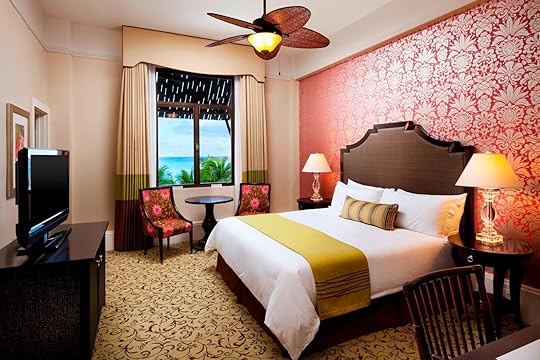 Photo: Vio.com
Photo: Vio.com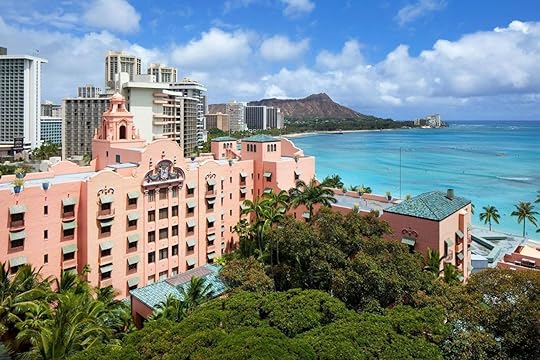 Photo: Vio.com
Photo: Vio.com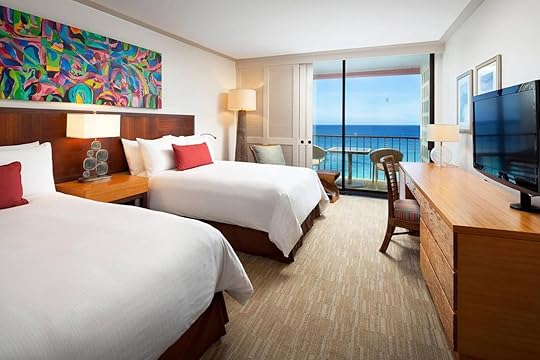 Photo: Vio.comSee more photos
Photo: Vio.comSee more photos
This hotel has been an icon on the island for nearly a century, and known for its luxurious hospitality offerings and classic style. It’s affectionately referred to as Waikiki’s original “Grand Dame,” with a history dating back to the late 1920s. Since then, the Royal Hawaiian has stood the test of time as an upscale destination made for those seeking an elegant retreat. You’ll immediately admire the glittering chandeliers, quirky original design elements like authentic mail chutes, and classic black-and-white tiled patio space that feel like taking a trip back in time to a golden era of more simplistic form of relaxation. Its oceanfront, city center location makes it feel the best of both worlds for those who want to mix urban escapades with lazy beachside days. You can indulge in a treatment at the on-site spa, grab a drink at the beach bar, the poolside bar (or both), or dine at one of the multiple restaurants serving a range of Hawaiian cuisine and offer ocean views and feel like a true royalty.
The Royal Hawaiian: 2259 Kalākaua Ave, Honolulu, HI 96815
The Ritz-Carlton Residences, Waikiki Beach Photo: Vio.com
Photo: Vio.com Photo: Vio.com
Photo: Vio.com Photo: Vio.com
Photo: Vio.comSee more photos
This chic property is tucked away from the hustle and bustle of Waikiki’s main strip, located away from the beaches close to the high-end shopping district, Luxury Row. But don’t fret — you’ll still be just a five-minute walk from the ocean. Upon walking into the lobby which is perched on the eighth floor, you’ll be met with ocean views and attentive service. Guest accommodations seem more like full-sized, fully furnished featuring white tones and light accents, and offering separate living room areas, balconies, fully equipped kitchens and even washing machines. It feels like a “home” (but with large and luxurious marble-clad bathrooms, and exceptionally better hospitality offerings). There are two infinity pools with fantastic city views, as well as a fully equipped spa and fitness center. There are multiple restaurants on-site — but you should definitely book a seat ahead of time for one of the 10 spots at Sushi Sho, which takes reservations over the phone.
The Ritz-Carlton Residences: 383 Kalaimoku St, Waikiki, HI 96815
Aston Waikiki Beach Tower Photo: Aqua-Aston Hospitality
Photo: Aqua-Aston Hospitality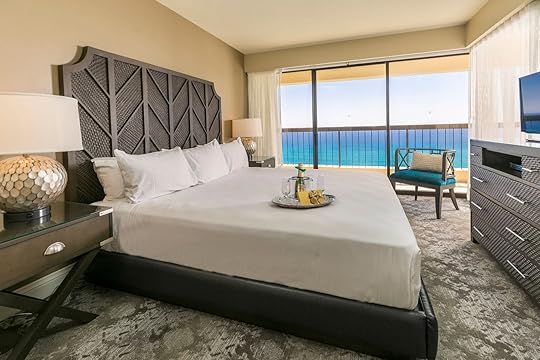 Photo: Aqua-Aston Hospitality
Photo: Aqua-Aston Hospitality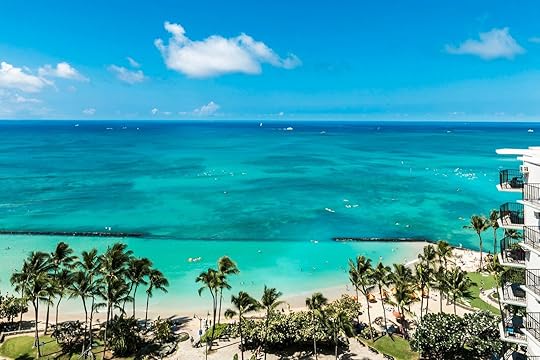 Photo: Aqua-Aston Hospitality
Photo: Aqua-Aston HospitalitySee more photos
Aston Waikiki Beach Tower sits directly across from Waikiki Beach. The luxury property offers suites – essentially fully equipped condos. This means you get a kitchen, living area, balcony, and separate sleeping space. It’s an excellent option for families or those who want the flexibility of preparing some meals themselves during their stay. The location is unbeatable, with a sundeck that overlooks the famous beach equipped with grilling facilities and cabanas.
Aston Waikiki Beach Tower: 2470 Kalākaua Ave, Honolulu, HI 96815
Moana Surfrider, A Westin Resort & Spa, Waikiki Beach Photo: Vio.com
Photo: Vio.com Photo: Vio.com
Photo: Vio.com Photo: Vio.com
Photo: Vio.comSee more photos
The Moana Surfrider sits just off Kalakaua Avenue, and is the oldest resort in Hawai’i, having first introduced the outside world to the inner generosity of Hawaiian hospitality in 1901. In homage to its history, it’s often referred to as the “First Lady of Waikiki,” today hosting its guests with contemporary amenities mixed with a traditional sense of timeless charm. Immediately upon stepping into the lobby of this impressive building from the stately porch, you’ll admire the original elements of classic architecture. The high ceilings and study columns tower up to high ceilings, paired with a humble sense of grandeur. The property is centered around a massive 75-foot tall Banyan tree, which stood at just seven feet tall at the time of its planting in 1907 — and today offers those who sit in the property’s courtyard an abundance of shade. It feels like there’s always something happening on-site, as it’s perfectly placed between Waikiki’s main street and the beach, putting it in an ideal location for many types of travelers. Spend time at the beach bar, dining at one of the multiple on-site restaurants, relaxing at the spa, or browsing the on-site art gallery. It’s a timeless and unpretentious spot to spend a night in the middle of it all.
Moana Surfrider: 2365 Kalākaua Ave, Honolulu, HI 96815
The Laylow, Autograph Collection Photo: Vio.com
Photo: Vio.com Photo: Vio.com
Photo: Vio.com Photo: Vio.com
Photo: Vio.comSee more photos
This colorful, contemporary, design-focused property is set in a central location of the city just two blocks from the beach, one block from Kalakaua, and adjacent to the International Marketplace. There’s an abundance of dining and drinking opportunities within walking distance of the property, but you might not want to leave the hotel due to the fun you’ll find lounging at the chic pool or relaxing next to one of its cozy fire pits in the lush garden lanai. The hotel feels like a young, hip, fresh spot to hang out, boasting unique amenities such as complimentary daily ukulele lessons, and multiple spots to eat and drink including the brews at HIDEOUT Coffee bar, or at TEX808 BBQ + Brews. The bright and airy guest rooms make you feel like you’ve woken up inside of a breezy island vacation movie, and the hospitality is warm and welcoming, but approachably casual.
The Laylow, Autograph Collection: 2299 Kūhiō Ave., Honolulu, HI 96815
Is there a hotel at the Honolulu airport?There’s no dedicated airport hotel but the Airport Honolulu Hotel is located just a few minutes away from the airport and offers guests comfortable amenities including an outdoor pool, a fitness center, clean rooms, and a convenient airport shuttle.
How far is Honolulu airport from the city?Daniel K. Inouye International Airport is about 10 minutes from Downtown Honolulu, 20 minutes from downtown Waikiki, and 25 minutes from Waikiki Beach. Ground transportation is readily available from the airport, including hotel shuttles to many of the resorts in Waikiki. 
May 21, 2024
A First-Timer’s Guide to Sardinia, Italy

For Italians, Sardinia is synonymous with “Costa Smeralda” (Emerald Coast), the summer playground of the rich and famous. But the natural and cultural attractions of the second-largest island in the Mediterranean are available to many travelers, not just the glitterati who gather on their mega-yachts at Porto Cervo every August.
The lifestyle of Sardinia alone is an attraction, since people here live longer, healthier, and better lives than almost anywhere else. Some villages boast almost 10 times as many centenarians (people more than 100 years old) per capita than the US. It could be that the food has something to do with it, but the stunning ocean vistas, strong family ties, and cohesion of the unique community likely all contribute, too.
Here are the best places to go and sights to see in Sardinia, Italy, plus advice on when to go, where to stay, and regional specialties you definitely don’t want to miss.
Jump to:Getting there and aroundWhen to visit SardiniaWhat to do in CagliariWhat to do in AlgheroWhat to do in BosaWhat to do on the Sinis PeninsulaWhat to do on AsinaraWhat to eat and drink Where to stay on SardiniaGetting there and aroundThere are no direct flights from the US to Sardinia, so you’ll need to fly to Rome, then catch a flight to Cagliari, Alghero, or Olbia. You can also connect through a dozen or more cities in Europe, including London, Frankfurt, Amsterdam, or Zurich, then fly on to Cagliari. The fastest travel time from JFK airport in New York City is just under 11 hours.The best way to get around Sardinia is by car, either driving yourself or by hiring a private driver. The distances are not huge, and it takes less than four hours to drive from Cagliari in the south to Santa Teresa Gallura in the north. Going from Oristano in the west to Tortoli in the east takes less than two hours. But the entire perimeter of the island is 1,149 miles, and it’s not a place to rush. You’ll want to allow enough time to linger on breathtaking seascapes, or stop for scrumptious meals.
The best time to visit Sardinia
The unique Carnevale celebrations of Barbagia start in January each year. Photo: Tore65/Shutterstock
The best time to go depends on what you want to do. Summer is ideal for beaches and water sports, but it’s also the most crowded and costly. Spring and fall are perfect for hiking, outdoor sports, and sightseeing. If folkloric traditions are your thing, aim for Christmas (December), Carnevale (February), and Easter (March or April) for special ceremonies and markets, religious and not.
Of particular note is the Carnevale celebration in Barbagia, in the heart of Sardinia. It begins its Carnevale celebrations each year on January 16 with the bonfires of Sant’Antonio Abate. “Su Karrasecare“(Carnevale in the Sardinian dialect) is closely tied to the area’s agro-pastoral traditions, with pagan roots different from anywhere else in Italy.
Throughout the year, every town has its own sagra, or local food fair; you can find the schedule for most of them online. The wettest and rainiest month is November, and the coldest is January, with an average daily high and low of 58 and 43 degrees Fahrenheit, respectively. But that also makes them the least crowded and most affordable.
What to do in SardiniaCagliari
Photo: Roman Babakin/Shutterstock
Cagliari is the largest city of Sardinia and the island’s major airport hub, but it feels uncongested, with sunshine, ocean walks, wide tree-lined avenues, and pastel-colored buildings. The varied architecture is living testimony to the many cultures that have contributed to Sardinia over the centuries: Phoenicians, Punics, Romans, Greeks, Spanish, and mainland Italian city-states.
The elevated historic area, Castello, holds the most important architectural and cultural monuments of Cagliari, including churches, palaces, museums, museums in palaces, the bastions of Santa Croce and St. Remy, the “Elephant Tower” (with a marble elephant to justify the name), and a building called “The Ghetto” (near the former Jewish ghetto). The best way to see it is on foot with a guided or self-guided walking tour – though you can also hitch a ride on the Cagliari tourist train through Castello, too. It’s only 10 Euros, and you buy your tickets on board.
The Museo Archeologico Nazionale (National Archeological Museum) merits a visit for two intriguing exhibits: a collection of bronze Nuragic statues (the bronzetti) and 16 of the 28 “Mont’e Prama” stone giants.
The bronzetti are mysterious because bronze contains copper, and there are no copper mines in Sardinia. Experts speculate that locals traded obsidian – a hard volcanic rock found on this volcanic island — for the desired copper. The stone giants are part of a collection of 28 massive sculptures discovered near Mount Prama, starting in 1974. Some are up to 10 feet tall and date between the 11th and 8th centuries BCE. That makes them the oldest anthropomorphic (human-like) sculptures found in Mediterranean Europe. The statues’ eyes are hypnotically large and compelling, leading some to whisper that aliens were the original role models.

Poetto beach in Cagliari, Sardinia, Italy. Photo: Torruzzlo/Shutterstock
About an hour north of Cagliari is Sardinia’s only UNESCO World Heritage site: Su Nuraxi di Barumini. There, you’ll find nuraghi, a special type of defensive structure found only in Sardinia. They date to the Bronze Age and are defensive stone towers shaped like truncated cones. The complex at Barumini is arguably the best example of nuraghi, but you’ll find them all over the island.
The three-day Festa della Madonna del Naufrago (the festival of the shipwrecked Madonna) is a yearly event held above and below water every third week in July. It’s held off the coast of the Isola dei Cavoli south of Capo Carbonara, about an hour southeast of Cagliari. In addition to the usual processions, food feasts, and music, the festival includes a ceremony held 33 feet underwater in which a priest blesses a 10-foot-tall statue of the Madonna. Only divers and fish can “hear” the blessing, but no one questions its power to protect sea-going fishermen and sailors.
Also at Capo Carbonara is a wide lagoon called Stagno Nottieri (Nottieri Pond). It’s home to both migratory and year-round pink flamingo populations. Guided tours will take you there, but it’s easy to find Nottieri — and the birds — on your own.
Alghero
Photo: Grzegorz Majchrzak/Shutterstock
The city of Alghero lies along a coastline known as the Riviera del Corallo (Coral Riviera), named for the coral deposits exploited there. The Museo del Corallo (Coral Museum) in the city center is a testament to the importance of that resource, the city’s coat of arms even includes a red coral branch, and shows off the artistry of local craftspeople able to enhance the beauty of red coral in jewelry and other objets d’arte. The museum is open daily, and tickets are only 5 Euros (about $6).
A walk on Alghero’s 13th-century-and later ramparts is a visual delight, with the sea and sun reflecting the pale ochre walls and towers, churches, domes, and forts. Alghero is one of only a few Italian cities to have maintained 70 percent of its original walls and is a gorgeous place for a leisurely stroll.
A strictly Sardinian curiosity is that a small (and diminishing) number of locals speak a variant of Catalan, reflecting the rule of the city for hundreds of years by the Aragons of northeastern Spain. Additional proof of the impact of Spanish culture is in the city’s nickname: Barceloneta, or “little Barcelona.”
Alghero offers a variety of interesting museums, churches, and fortresses. The city doesn’t have any must-do sites to check off in a frenzied fashion like Paris or London, but worthy of a visit is the Cattedrale di Santa Maria Immacolata di Alghero (Alghero Cathedral), where construction started in 1570 but wasn’t completed for 150 years. The cathedral’s Torre del Portal (Port Tower) was built in 1560, and was the control point for access to and from the city center. It’s also known as the Torre degli Ebrei (the Jewish tower), perhaps because the Jewish community helped fund it. The entire site is free to visit.

The many steep stairs leading to Neptune’s Grotto on Sardinia. Photo: marcociannarel/Shutterstock
About 14 miles from Alghero is Porto Conte Park, where you can visit Neptune’s Grotto, or Grotto di Nettuo. If you start your visit on land, you’ll need to go up and down 656 steep and not-easily-navigated steps. But you’ll be rewarded with the sight of a half-mile sandy beach, an underground salt lake, and four soaring limestone rooms inside the cave. You can also take one of the many daily boats headed to the grotto from nearby Port of Alghero (just buy tickets at the port). If you’re coming from land, you can buy your cave tour online. If you come via boat, you can just buy your ticket when you arrive, as tickets to the cave aren’t included in the cost of the boat ride.
For those who prefer to exert themselves underwater, Nereo, off Capo Caccia, is the largest submerged marine cave in the Mediterranean.
Bosa
Phtoo: DaLiu/Shutterstock
Bosa’s reputation as one of the prettiest villages in Italy is richly deserved. Its pastel-hued homes and wrought-iron balconies set on a hill overlooking the sea are reminiscent of Chile’s Valparaiso. Little more than a mile away is Bosa Marina, the town’s beach area that’s known for clean and clear water. Dominating the landscape is the Malaspina Castle, where all visits include a guided tour in multiple languages and admission is 6.50 Euros (about $7.50)
Wine is a central part of life here, particularly the (usually) white Malvasia wine from the region.
The Sinis Peninsula
Tharros, on the Sinis Peninsula. Photo: Gabriele Maltinti/Shutterstock
About one hour to 90 minutes south of Bosa is the Sinis Peninsula, where you can encounter more of the Mont’e Prama stone giants. Head to Cabras to visit the Museo Civico Giovanni Marongiu. It’s a compact, handsome space built in 1997 to house six of the 28 giants found to date. Signage is in Italian and English, and it’s currently being enlarged to accommodate an additional 13 statues currently in Cagliari.
A great second stop on the peninsula is Tharros. It’s a crossroads of Sardinian conquest, with Nuragic, Phoenician, Punic, and Roman ruins layered on an extensive site. You can even see ridges in the surviving slabs of road that show where carts and chariots once rolled. It’s the most-visited archeological site in Sardinia, and open almost every day, with tickets priced at 9 Euros (about $10). You can email in advance to request a guided tour in English at no cost, but if you haven’t planned ahead, you can wander around independently or hire a private guide in town. Combined tickets are available for the archeological park and Civic Museum, and a train runs between the two in summer.
If you happen to be visiting Sardinia in September, you may want to plan your trip to see the tiny town of San Salvatore. It looks like a deserted Mexican village, with low-slung homes in sun-hardened yellow. In fact, it was used as a film set for spaghetti Westerns in the 1960s and 1970s. Today, the town is empty 350 days of the year — but during a concentrated period bracketing the first week of September, San Salvatore comes alive for the Corsa degli Scalzi, or “Race of the Barefoot.”
Up to 800 men run barefoot the seven miles from Cabras to San Salvatore while carrying a religious statue. A week later, a group of shoeless women walk the course in reverse, bringing the statue back to Cabras. The women are dressed in traditional costumes, the men in white garments. In between the two races are food festivals, performances by musicians and actors, religious programs, parades, and the chance to see a sleepy little 17th-century ghost town come to life.
Asinara National Park
Photo: Stefano Rulli/Shutterstock
Asinara is a small island above the northwestern tip of Sardinia. The name is Italian for “donkey-inhabited,” but the name is thought to derive from the Latin word “sinuaria,” meaning sinus-shaped. It used to be known as the “Alcatraz of Italy,” but today, most of the island is a national park. Visitors are drawn by the island’s stunning beauty and curious wildlife, including albino donkeys, wild boars, goats, and wild sheep.
The park is reached via public ferry from Porto Torres, though many tour operators offer their own transportation to the island. Hiking is a popular activity, with other activities like snorkeling, diving, and watersports available from operators in the island’s town of Cala d’Oliva
Where to eat and drink on Sardinia
Fregola with clam sauce. Photo: Alessio Orru/Shutterstock
Restaurants across the island range from simple trattorias to elegant eateries. Michelin currently recognizes 50 restaurants, six of them honored with star status. There are so many good restaurants that it’s not so much where to eat as what to eat.
Sardinian cooking stems from a pastoral society, not from the sea. But restaurants began adding seafood to their menus as the growing number of tourists demanded it, and the habit stuck. Dishes not to miss come in the form of fregola con cozze (toasted balls of semolina dough in a spicy tomato-and-clam sauce), taglioline con sugo di mare (a ribbon-like pasta, similar to spaghetti but much thinner, with a seafood sauce), and malloreddus (ridged semolina shells that look like smaller gnocchi and are served with seafood or sausage).
Another star of the show is culurgiònes. The dish of semolina-based ravioli filled with potatoes and cheese (usually pecorino Sardo) is topped with variations of mint, garlic, saffron, or other culinary whims. It differs from other ravioli by the distinctive wheat ear (spiga) design on each piece. That makes it a little thicker, so it can stand up to a thicker ragù sauce with wild boar punctuated with locally grown herbs.

Panadas are a typical Sardinian savory pie, filled with meat, potatoes and legumes. Photo: fabiano goreme caddeo/Shutterstock
Panadas are another typical dish, and each area of Sardinia has its own favorite. Panadas are the local version of Spanish empanadas. The dough is made with semolina flour and lard in southern Sardinia, though the lard may be replaced by olive oil elsewhere. The fillings change by region and season, but it’s usually combinations of vegetables like eggplant, peppers, mushrooms, zucchini, artichokes, or potatoes and some kind of meat; lamb is the most classically Sardinian. The dish is usually served with garlic, mint, and pecorino Sardo. The latter is a pride of the island and a major export. So is, despite the name, pecorino Romano. It’s just as likely to come from Sardinia as from Rome.
Sometimes found on menus but more commonly spotted in gift shops is bottarga, the salted and pressed roe from gray mullet or tuna. It’s known as the “oro di Cabras “(gold of Cabras), but you can find it all over Sardinia.
Ditto for the wines (this is Italy, after all). The best known are vermentino and cannonau, with producers north and south taking advantage of distinct micro-climates. Many organizations offer wine tours, and there are two official wine associations: the Strada del Gusto Nord Sardegna and the Strade dei Vini della Sardegna. (Google Translate helps for following the various brochures.)
A local favorite restaurant in Cagliari is Luigi Pomata, whose eponymous chef is known as the king of red tuna. The fish is used in dishes like “porgi l’altra guancia” (“turn the other cheek.”) Cleverly, it’s tuna cheeks braised in honey and served with cooked endive.
Where to stay in Sardinia
Casa Clat in Cagliari. Photo: Booking.com
As a sought-after summer tourist destination, Sardinia offers more than 22,000 lodging options, from modest bed and breakfasts to ultra-luxurious resorts charging more than $10,000 per night.
As a rule, coastal accommodations cost more than inland rooms, and hotels and resorts are pricier than agriturismos (farmstays). Since Italians stay for several weeks or more during the summer, be prepared to book well in advance during the high season.
We hope you love the spaces and stays we recommend! Just so you know, Matador may collect a small commission from the links on this page if you decide to book a stay. Listed prices are accurate as of the time of publication.
In Cagliari, Casa Clat is highly rated, with suites housed in a building from the 18th century and a well-balanced mix of historical and luxury details. It has an on-site restaurant and bar, plus an ocean-view rooftop and garden area with a small pool. Rates start around $260 per night.

The pool at Agriturismo Sa Jana. Photo: Booking.com
Airbnbs are also readily available in Cagliari, and highly rated options include this Airbnb with a rooftop terrace (starting at $170 per night), this artsy and airy Airbnb (starting at $130 per night), and this penthouse with a hot tub and lots of outdoor space (starting at $164 per night).
In Alghero, Airbnbs are cheaper and easier to find by the coast. Good options include this one-bedroom beachfront condo, this beach house with a garden just south of Alghero in Putzu Idu, or this fun houseboat that can sleep four guests.
Olbia is a very popular town to stay in on the Costa Smeralda, with a large variety of hotels to choose from. Options range from the chic (and expensive) Hotel Abi d’Oru on the beach to the much more budget-friendly Olbia City Hotel, starting closer to $90 per night (including breakfast). Popular farmstays around Sardinia include the adults-only Agriturismo Sa Jana on the east coast, Agriturismo La Rocca Manna just south of Olbia, and Ecoparco Neulè. The latter overlooks Lake Cedrino and has binoculars available to guests for bird and wildlife watching. 
Traveling to the Northernmost City in the World Is a Lot Easier Than You Think

The world is a very big place, but advancements in the field of air travel have made it a lot easier to visit every nook and cranny of it, even the most remote. Case in point: Qaanaaq, Greenland, is as remote as it gets, yet you can get there relatively easily.

Photo: Kedardome/Shutterstock
Located in the northwest of Greenland, this city of around 650 people came to be in 1953, when two settlements in the area were moved to Qaanaaq for the construction of the US air base known as Pituffik Space Base (formerly known as Thule).
While it is very small, Qaanaaq is considered a city, unlike Longyearbyen in Svalbard, which is located at a higher latitude but is recognized as a settlement. (Longyearbyen’s latitude is 77.8750° N while Qaanaap’s is 77.4670° N.)
Qupanuk Olsen, the woman behind Q’s Greenland, a social media channel all about the world’s largest island, recently traveled to Qaanaaq. To get there, she simply flew with Air Greenland from Nuuk, the capital of Greenland, to Ilulissat on the western coast, and then to Qaanaaq. The trip of about 745 miles requires spending around four hours in the air in a twin-engine turboprop airplane.
View this post on InstagramA post shared by Q’s Greenland (@qsgreenland)
Unsurprisingly, there is a very limited number of flight per week to and from Qaanaaq from Ilulissat and Upernavik, the two airports in Greenland that provide connections from Nuuk.
To get to Nuuk, however, is a lot easier, although it currently can only be done directly from Copenhagen in Denmark or Keflavik in Iceland. Starting in June 2024 and until October 2024, seasonal flights between Iqaluit, Canada, and Nuuk, Greenland, operated by Canadian North and Air Greenland as part of a partnership, will provide the only direct commercial air link between North America and Greenland. (After all, Canada is only 103 miles from Greenland.)
While Olsen is Greenlandic, she had never visited the northernmost city in the world until now. Through her Instagram posts, she takes us all around Qaanaaq while she tries out local food such as fermented narwhal meat, goes dog sledding, and meets local Inughuit people.
View this post on InstagramA post shared by Q’s Greenland (@qsgreenland)
The people of Qaanaaq still rely on ancestral traditions for their survival, such as fishing and hunting with dog sleds and kayaks. They also speak a Greenlandic dialects that’s used only by a few hundred people: North Greenlandic, AKA avanersuarmiutut.
If you plan to visit Qaanaaq, just remember that, because it is so far above the Arctic Circle, for five months out the year, in the summer, the sun never sets; and for 3.5 months out of the year, in winter, the sun never rises above the horizon. 
A New Six-Country Visa Means Easier Travel to the Middle East

Thanks to a brand-new visa just announced for some countries on the Persian Gulf, traveling through growing tourist countries like Qatar and the UAE just got far easier.
The Gulf Cooperation Council (GCG) recently shared more details about the upcoming “GCG Grand Tours,” visa, which will allow visa holders to travel freely through partner countries Oman, Qatar, Saudi Arabia, the United Arab Emirates (UAE), Kuwait, and Bahrain. The partnership was announced at a Middle East travel trade show by the UAE Minister of Economy Abdulla bin Touq Al Marri. The idea behind the visa is to allow visitors to travel throughout all six countries and only show their passport upon arrival at airport customs. It’ll likely be similar to Europe’s “Schengen Area,” which allows visitors to move between 17 countries without showing their passport or identification when crossing boarders.
Currently, you’ll need separate visas to country hop, and most allow you to stay only 30 days or less. (Bahrain’s is only two weeks, and you can stay for up to three months in Kuwait or Saudi Arabia). The new visa will allow visitors to stay longer than 30 days, though the exact length is yet to be announced. It’ll make it easier for visitors to quickly travel though the region and explore additional countries on the Persian Gulf. The visa website is still under development and doesn’t yet list an application cost, though it says it will launch in December 2024.
The Grand Tours Visa is a major step in an ongoing effort to grow tourism in the Persian Gulf. In 2019, Saudi Arabia removed most of its laws around dress codes for women and introduced a speedy e-visa process for western travelers, and Qatar invested big in tourism when it hosted the . Cities like Dubai and Abu Dhabi in the UAE have become synonymous with some of the biggest, tallest, and most impressive man-made tourist destinations in the world, and the Burj Khalifa’s Atmosphere Restaurant serves the world’s highest cocktails.
Where to go with the new Middle East visaHolders of the new shared visa will be able to move around the various sites and cities in the six countries quicker and easier than ever before, allowing visitors to fit more sightseeing into one trip. Fortunately, even a single country in the Gulf Cooperation Council has plenty to fit a vacation, so with six at your fingertips, the hardest part will be figuring out how long you can be away.
AlUla, Saudi Arabia
Arch Rock in AlUla, Saudi Arabia. Photo: Biddulph Photography/Shutterstock
In the northwest corner of Saudi Arabia is AlUla, a UNESCO World Heritage Site that transcends time. Once a vital crossroads on the incense trade route, it’s now a captivating destination where ancient history collides with modern luxury. The town hides layers upon layers of history and cultures, and is near Hegra, where Nabataean tombs were meticulously carved into cliffs 2,000 years ago. Old Town Alula offers a chance to see what life was like in Saudi Arabia thousands of years ago, with traditional dining, city tours, and gorgeous hotels like the Banyan Tree AlUla’s tented villas or the absolutely stunning Our Habitas AlUla, built into an ancient canyon.
Doha, Qatar
Souq Waqif in Doha. Photo: Marius Dobilas/Shutterstock
Doha, the capital of Qatar, is a fascinating city, with modern skyscrapers casting shadows over traditional souqs more or less unchanged over the centuries. History buffs can delve into the nation’s rich past at the National Museum of Qatar, housed in a stunning, desert rose-inspired building, and art enthusiasts will find treasures at the Museum of Islamic Art, home to an extensive collection spanning centuries.
You’ll also want to make time to wander the labyrinthine alleys of Souq Waqif, a traditional marketplace overflowing with spices, perfumes, and handcrafted souvenirs. (And yes, haggling with friendly vendors is all part of the experience, regardless of your language skills). Just outside of the city, travelers can explore sand dunes, lounge at a beach club, or go stargazing under a canopy of stars at the unique Outpost al Barari glamping resort.
Oman’s Wadi hiking trails
Wadi Bani Khalid. Photo: elesi/Shutterstock
Oman’s wadis (verdant canyons carved by ancient floods) offer a unique backdrop for adventurous hikers. Trails wind through towering cliffs several millennia old, with the occasional lush palm groves for shade and off-and-on scent of frankincense. Hiking in Oman can range from gentle strolls to multi-day tours with camping in between.
Wadi Bani Khalid, for instance, is a popular choice with its easily accessible swimming holes. The more adventurous can tackle Wadi Shab, which requires a short boat ride followed by a hike through knee-deep water and narrow passages to reach a hidden cave with a cascading waterfall. Hiking is a developing industry in the country, but guiding companies like Bike & Hike Oman or Oman Trekking Guides can lead the way. 
This Dreamy Costa Rican Hotel Feels Like Your Own Private Rainforest

For every night that a guest books a stay at Hotel Three Sixty in Costa Rica, a tree is planted. The adults-only boutique hotel is nestled within a 58-acre rainforest reserve in Ojochal, a village in the Puntarenas Province that spans Costa Rica’s western coast. It partners with One Tree Planted to give back to its natural surroundings, but Hotel Three Sixty and its setting are equally restorative for guests. I should know: as a visitor from the Canadian Rockies — where the climate is dry and cold for eight months out of the year, and greenery is scarce — it was as if my stay at the hotel replenished me from those months without sunlight and vitamin D.
Indoor-outdoor villas that immerse you in the rainforest
Photo: Hotel Three Sixty
Upon entering Hotel Three Sixty, I was greeted with a complimentary guava smoothie, giving me a literal taste of the Costa Rican bounty that rings the property. Hotel Three Sixty has 12 villas; I stayed in a deluxe villa. At 516 square feet — with a 130-square-foot balcony — the deluxe villa is one of the biggest hotel rooms I’ve ever lodged in.
What stood out to me first in the spacious bedroom was the expansive windows, which open to breathtaking views of the rainforest and Pacific Ocean from any angle. This indoor-outdoor design immerses you in the lush landscape even when you’re in your room, which comes outfitted with a king-size bed, a his-and-hers bathroom, a separate half bath, standard amenities including a fully stocked bar, and Indonesian furniture that fosters both elegance and comfort.
My favorite feature of the villa was the balcony. Furnished with a coffee table and two chairs, the balcony was the perfect place to start the day, sipping a morning beverage while listening to the soothing sounds of the surrounding wildlife. But on days when it’s too hot and humid to sit comfortably outside, you can still admire the view from the comfort of the air-conditioned room.
The ultimate pool and spa days
Photo: Hotel Three Sixty
Hotel Three Sixty has a host of amenities that reinforce its natural beauty, from an infinity pool overlooking the Pacific Ocean, to a rainforest spa and yoga deck, to hiking trails. And because the hotel only has 12 rooms, the common spaces are never crowded. This proved to be particularly refreshing at the panoramic pool and poolside bar. Eventually, the hotel staff will learn your name and your favorite drink or preferred bite, adding to the sense of intimacy.
At the hotel’s spa, you can book treatments ranging from facials to massages and body scrubs. During my visit, I opted for the hot stone massage. Ten minutes before my appointment, a golf cart picked me up in the hotel lobby and whisked me two minutes away to an indoor-outdoor wellness center that’s divided into two sections: half gym, half spa. The waiting area offered shelter from the tropical rain outside.
When I met my massage therapist, Shirley, I was able to select a target area and quickly drifted into a deep relaxation — so much so that I fell asleep. After my treatment, I was offered a tea of my choice and escorted back to the main property.
Dining at Hotel Three Sixty and beyond
Photo: Hotel Three Sixty
Hotel Three Sixty’s on-site bar-restaurant, Kua Kua Bar, serves breakfast, lunch, and dinner daily until 9:30 PM. The menu is diverse, featuring options like chia seed pudding and French toast, a traditional Costa Rican breakfast, and sushi and poke, as well as a variety of vegan and gluten-free dishes. While it’s not included in the booking cost, I’d recommend getting breakfast included during your stay — not only is the food delicious and convenient, but the hotel’s secluded location also means no nearby shops or breakfast spots within walking distance.
The closest off-property restaurant is called Citrus. It’s a five-minute drive, and the hotel can arrange transfers. Citrus serves a blend of French, Costa Rican, and European meals in an airy atmosphere. All of the food I tried at Citrus was fresh and packed with bright flavors — one standout was the steak frites with chimichurri.
View this post on InstagramA post shared by Fuego Brewing Co. (@fuegobrewco)
Roughly 40 minutes from the hotel, Fuego Brew Co is a must-visit if you want to sip craft beer in a jungle-like setting. Fuego’s in-house brewery pours exclusive beers that pair nicely with its range of Costa Rican and American fare. Some of my favorite dishes were the patacones (fried plantains) and ceviche. While the beer and menu largely cater to adult taste buds, Fuego is also welcoming for kids.
Another restaurant in the area, Heliconia, is located 15 minutes from the hotel. Heliconia is more upscale than Fuego but on par with Citrus, with an ambiance that feels like an extension of the rainforest. The menu is a mix of Costa Rican dishes and international cuisine. The sea bass, rice, and vegetable plate with Caribbean sauce that I ate there was one of my favorite meals of my trip — spicy but delicious.
Outdoor activities on and off the property
Photo: Nature’s Charm/Shutterstock
You don’t need to travel far to participate in one of Ojochal’s finest activities: nature walks. In fact, Hotel Three Sixty has a network of nature trails that cover a little less than a mile of moderate terrain. As you walk, take in the area’s biodiversity and wildlife, including eagles, hummingbirds, toucans, scarlet macaws, and capuchin monkeys. The hotel can provide binoculars for optimal viewing.
Another exciting adventure within an hour’s drive of the hotel is the Nauyaca Waterfalls. There, you can climb the falls and jump into the large basin below to swim, as well as explore the rainforest and falls area on foot or by horseback. Ask the hotel about arranging a transfer or excursions — just be sure to book the activity in advance as hourly time slots are limited.
For a different perspective on the rainforest environment, consider a Sierpe Mangrove Tour. Beginning with a 45-minute drive from the hotel, this 2.5-hour guided boat tour along the Sierpe River creates an opportunity to observe countless species, from monkeys and birds to Jesus lizards, crocodiles, turtles, and macaws. Of course, you’ll also get to see a mangrove forest up close.
How to get to Hotel Three Sixty
Photo: Hotel Three Sixty
There are several ways to reach Hotel Three Sixty. I flew 4.5 hours from Newark Liberty International Airport (EWR) in New Jersey to San José, the capital of Costa Rica. Upon arrival at Juan Santamaría International Airport, my group took a shuttle to a nearby domestic airport — the transfer only took a couple of minutes. From there, we boarded a private mini-plane for a 20-minute flight to the Quepos airport. Finally, a private shuttle drove us to the hotel, which took about an hour, and a car led us into the gated property. You can also arrange a private car transfer through the hotel or rent a car and drive four hours to the property from the airport. This is a cheaper alternative but may take longer due to traffic.
When planning a visit to Hotel Three Sixty, be sure to account for travel time and the various transportation options, as reaching the property might take an entire day. If you intend to rent a car and drive from the airport or off the property, choose an SUV due to the uneven roads. 
The One Small Thing Spice Lovers Should Pack in Their Luggage Before Every Trip

We hope you love the products we recommend! Just so you know, Matador may collect a small commission from the links on this page.
I am not typically one for souvenirs. What I will almost always try and bring back from my travels, however, are local spices. They bring the flavors back home, and make excellent gifts that will get more love than that tacky magnet that most likely can be found just as easily online (and probably wasn’t made in the country you bought it regardless).
Getting said spices back home in a way that keeps them tasting as good as I remember in their country of origin takes a little more work than bringing back an article of clothing or piece of plastic. Which is where some repurposed silica gel packets come in handy.
Silica gel packets are thrown into seemingly every product you buy. New camera lenses, shoes, chips — ubiquitous is the only fitting word. They fall in the category of desiccants, which mean a material that absorbs moisture. They’re particularly handy in humid areas where the air has enough water in it to make food clump or turn stale. The pellets are made with silica and water. As Discover explains, the molecular structure is sponge-like. The H2O in condensed humid air clings on to the silica gel, thereby removing it from the nearby air.

Photo: Anna Hoychuk/Shutterstock
By some measures, silica gel can absorb 30-40 percent of its weight in water. One study found 20-30 percent of absorption by weight at 90 percent relative humidity and 86 degrees Fahrenheit over 30 days. That’s not as strong as other desiccants like calcium chloride, though silica gel does better in relative humidity of about 50 percent and still performs more than enough for most travelers’ needs.
Through my years of bringing back spices from trips to places like India, United Arab Emirates, and Mexico, spice clumping issues have popped up more often than I’d like. Pre-packaged goods are usually in the clear (often because they already have a silica gel packet in them), but the spices I tend to gravitate toward are the ones put together locally and scooped from a bin and into a plastic bag. A hard clumped bag of spices isn’t necessarily completely ruined, but it’s also not true to form.
I first put the connection together that silicon gel packets could help after watching videos from travel influencers and travel advisors on TikTok.
@patricejwill Silica gel packs have a ton of uses, especially when traveling. They’re great at absorbing moisture. Throw a few in your suitcase and they can even help dry your phone out if it gets wet {do not put your phone in rice} #travelhacks #travelpackingtips #packinghacks #travelwriterslife ♬ original sound – Patrice | solo travel fashion
A couple of weeks ahead of a trip to Jamaica, I started tossing these packets in my Away suitcase instead of the trash. I had a few handfuls zipped into a pouch by the time I left. Jamaica’s average humidity sits at 70 percent or higher year-round — significantly higher than the 30 percent range in my hometown of Denver.
In Jamaica, I put a few into a bag filled with jerk spices from an outdoor market in the heart of Ocho Rios. The woman putting the spices together warned me that the sugars in the mix — an ingredient especially prone to clumping in humidity — could lead to a hardened mass by the time I left five days later.
With my extra silica gel packets doing their work, everything was in the same shape I bought it when I got home and unpacked.
Spices aren’t the only thing that benefit from some silica gel packets in your luggage. Electronics, camera gear, stinky clothes that have been sweat through (silica gel is also a deodorizer), and makeup all benefit from a lower relative humidity as well. Just remember that they can lose effectiveness over time, so you’ll need to switch packets out after a few uses.

Photo: Nickolaus Hines
My main concern as someone traveling with a toddler was the very clear “DO NOT EAT” warning on every package. Zipping them away gave me some peace of mind. The fact that silica gel is nontoxic gave me more. They’re still a choking hazard, and self-indicating silica gel can have toxic ingredients, but the regular packets won’t usually lead to a hospital trip.
While I went the route of reusing the ones that made it my way in other packages, you can also buy fresh silica gel packets on Amazon for under $10.
These little packets (the ones not dusted over in chip residue, at least) officially have a forever home in my luggage for spices of all kinds. 
What I Packed for a Few Laid-Back Days in Barcelona

On my first trip to Barcelona, I had a solid schedule for my three days in the city. Thanks to my Go City sightseeing pass, I had booked guided tours of La Sagrada Família and Park Güell, and a ride onboard the Montjuïc cable car. I also made plans to visit the atmospheric Gothic Quarter and try out the Teleférico del Puerto (the port cable car). When it came to choosing a place to stay, I randomly picked the tourist-free, laid-back neighborhood of El Poblenou. With a main pedestrian street full of cafes, bakery, restaurants, and local shops, as well as a beautiful beach, Playa de Bogatell, it was the perfect location to get back to at the end of a day filled with tourist crowds. Of course, having planned this trip meticulously, I packed my luggage with the same mindset. A bathing suit to enjoy the 85-degree weather on the beach, a comfortable and casual pair of shoes for the many miles I planned to walk every day, weather-appropriate and fun outfits that could work for both day and night, and a book that would immerse me into the city.
We hope you love the hotels and products we recommend! Just so you know, Matador may collect a small commission from the links on this page if you decide to book a stay or make a purchase. Listed prices are accurate as of the time of publication.
Where to stay in Barcelona’s El Poblenou Photo: Vio.com
Photo: Vio.com Photo: Vio.com
Photo: Vio.com Photo: Vio.comSee more photos
Photo: Vio.comSee more photosAt the northern end of El Poblenou, alongside the busy Avinguda Diagonal, Barcelona’s biggest avenue, is Meliá Barcelona Sky, a four-star ultra-modern hotel. The striking contemporary architecture of this luxury establishment, designed by renowned French architect Dominique Perrault, is only one of its many appeals. The sixth-floor pool, with its cabanas and loungers is a relaxing place to hang out, and so is the spa and the 24th-floor terrace from where you can get a bird’s eye view of the city. Book a room up high so you can wake up to vistas of the Mediterranean Sea. Meliá Barcelona Sky is 10 minutes on foot from the main pedestrian street of El Poblenou and less than 20 minutes to the beach.
Book Now from $297What I packed for a few days in BarcelonaPrimaDonna Swim MarivalView this post on InstagramA post shared by PrimaDonna Lingerie (@primadonnalingerie)
PrimaDonna is a lingerie brand that caters to all body types, with a very solid selection of swimwear and bras for women with busty, curvy bodies. The collections are always colorful and fun, with a variety of motifs and multiple versions of bikini bottoms and tops so that everyone can find the fit that works for them, no matter their size, preference, and comfort level.
Buy now from Glamuse from $231Suncloud Metric sunglassesView this post on InstagramA post shared by Suncloud Polarized Optics (@suncloudeyewear)
I dislike wearing sunglasses but you really can’t go without when visiting sunny Barcelona. This classic tortoise shell, polarized Metric frame from Suncloud works for all occasions and is comfortable, making wearing shades a lot less of a chore for those who don’t care for it. Because the Suncloud Metric is an affordable, plastic-frame model for everyday wear, I don’t feel particularly worried about scratching them or putting them back in their case after every single use.
Buy now from Amazon for $43.96Neutrogena Ultrasheer Dry Touch sunscreenView this post on InstagramA post shared by Neutrogena (@neutrogena)
I am extremely fair-skinned, with freckles all over, and a tendency to burn very quickly and very intensely, so there is no way I can be out in the Spanish sun without protection. Neutrogena’s Ultrasheer Dry Touch sunscreen is the only sunscreen that does not leave me shiny and with white streaks. It’s light, very fast absorbing, and leaves a matte, transparent finish so you can wear it all over your body and face without feeling sticky and gross. Just remember to apply every two hours for the best skin protection.
Buy now from Amazon for $8.88Pismo casual sneaker by VionicView this post on InstagramA post shared by Vionic Shoes Canada (@vioniccanada)
If you’re going to explore a city like Barcelona where the weather is hot on foot, forget the sandals and opt for a low-rise, casual sneaker like Vionic’s Pismo. You can walk many miles in them without discomfort thanks to their arch-support insoles and they still look good with a simple dress, a pair of shorts, or jeans. The Pismo sneaker comes in a variety of colors and motifs so you can make them match all your outfits. I own two pairs: one with a strawberry pattern and one plain navy blue, and I would not trade them for any other shoes. Also, when they get too dirty, you can throw them in the washing machine on a cold cycle (without the insoles) and they come out looking brand new.
Buy now from Amazon from $44.98The Shadow of the Wind by Carlos Ruiz ZafónView this post on InstagramA post shared by Carlos Ruiz Zafón (@zafonoficial)
The Shadow of the Wind, or La Sombra del Viento in Spanish, is a work of Gothic fiction that takes place in Barcelona. Written by late Carlos Ruiz Zafón, himself born in Barcelona, the story is a dark thriller with some elements of magic, that is sure to suck you right in and make your spine tingle. Take it with you to the Gothic Quarter and try to match the real-life locations to those in the novel. And if you like this one, there are four more that follow in the same vein — although they can all be read independently.
Buy Now from Amazon for $9.99Marie Dress from Lucas du TertreView this post on InstagramA post shared by Lucas du Tertre (@lucasdutertre.paris)
For a casual, yet elegant look, I opted for a knee-length button-down shirt dress from Parisian brand Lucas du Tertre. Made of 100 percent light cotton, with short sleeves, this dress is extremely comfortable for all body types, especially in hot weather. Both the blue gingham and the red stripes versions are equally beautiful and easy to wear.
Buy Now from Lucas du Tertre for $119.38Wallaroo hatView this post on InstagramA post shared by Wallaroo Hat Company (@wallaroohats)
Much like you need to protect your eyes with sunglasses and your skin with sunscreen, you need to protect your scalp with a hat. The Australia-based Wallaroo Hat Company makes UPF-fabric hats in a huge variety of models to suit everyone’s style. I travel with the stylish and packable Sedona Fedora in white, made of UPF-50, lightweight fabric. It has a long brim to shield your face and an inner drawstring to adjust for a perfect fit. 
Matador Network's Blog
- Matador Network's profile
- 6 followers




